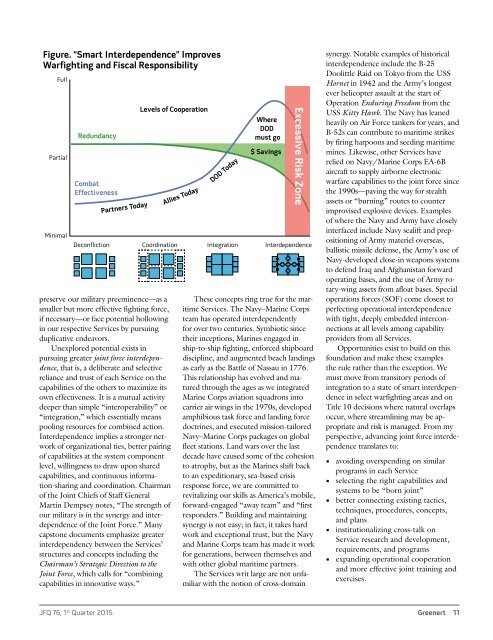jfq-76
jfq-76
jfq-76
Create successful ePaper yourself
Turn your PDF publications into a flip-book with our unique Google optimized e-Paper software.
Figure. “Smart Interdependence” Improves<br />
Warfighting and Fiscal Responsibility<br />
Full<br />
Partial<br />
Minimal<br />
Redundancy<br />
Combat<br />
Effectiveness<br />
Partners Today<br />
preserve our military preeminence—as a<br />
smaller but more effective fighting force,<br />
if necessary—or face potential hollowing<br />
in our respective Services by pursuing<br />
duplicative endeavors.<br />
Unexplored potential exists in<br />
pursuing greater joint force interdependence,<br />
that is, a deliberate and selective<br />
reliance and trust of each Service on the<br />
capabilities of the others to maximize its<br />
own effectiveness. It is a mutual activity<br />
deeper than simple “interoperability” or<br />
“integration,” which essentially means<br />
pooling resources for combined action.<br />
Interdependence implies a stronger network<br />
of organizational ties, better pairing<br />
of capabilities at the system component<br />
level, willingness to draw upon shared<br />
capabilities, and continuous information-sharing<br />
and coordination. Chairman<br />
of the Joint Chiefs of Staff General<br />
Martin Dempsey notes, “The strength of<br />
our military is in the synergy and interdependence<br />
of the Joint Force.” Many<br />
capstone documents emphasize greater<br />
interdependency between the Services’<br />
structures and concepts including the<br />
Chairman’s Strategic Direction to the<br />
Joint Force, which calls for “combining<br />
capabilities in innovative ways.”<br />
Levels of Cooperation<br />
Allies Today<br />
DOD Today<br />
Where<br />
DOD<br />
must go<br />
$ Savings<br />
Excessive Risk Zone<br />
Deconfliction Coordination Integration Interdependence<br />
These concepts ring true for the maritime<br />
Services. The Navy–Marine Corps<br />
team has operated interdependently<br />
for over two centuries. Symbiotic since<br />
their inceptions, Marines engaged in<br />
ship-to-ship fighting, enforced shipboard<br />
discipline, and augmented beach landings<br />
as early as the Battle of Nassau in 17<strong>76</strong>.<br />
This relationship has evolved and matured<br />
through the ages as we integrated<br />
Marine Corps aviation squadrons into<br />
carrier air wings in the 1970s, developed<br />
amphibious task force and landing force<br />
doctrines, and executed mission-tailored<br />
Navy–Marine Corps packages on global<br />
fleet stations. Land wars over the last<br />
decade have caused some of the cohesion<br />
to atrophy, but as the Marines shift back<br />
to an expeditionary, sea-based crisis<br />
response force, we are committed to<br />
revitalizing our skills as America’s mobile,<br />
forward-engaged “away team” and “first<br />
responders.” Building and maintaining<br />
synergy is not easy; in fact, it takes hard<br />
work and exceptional trust, but the Navy<br />
and Marine Corps team has made it work<br />
for generations, between themselves and<br />
with other global maritime partners.<br />
The Services writ large are not unfamiliar<br />
with the notion of cross-domain<br />
synergy. Notable examples of historical<br />
interdependence include the B-25<br />
Doolittle Raid on Tokyo from the USS<br />
Hornet in 1942 and the Army’s longest<br />
ever helicopter assault at the start of<br />
Operation Enduring Freedom from the<br />
USS Kitty Hawk. The Navy has leaned<br />
heavily on Air Force tankers for years, and<br />
B-52s can contribute to maritime strikes<br />
by firing harpoons and seeding maritime<br />
mines. Likewise, other Services have<br />
relied on Navy/Marine Corps EA-6B<br />
aircraft to supply airborne electronic<br />
warfare capabilities to the joint force since<br />
the 1990s—paving the way for stealth<br />
assets or “burning” routes to counter<br />
improvised explosive devices. Examples<br />
of where the Navy and Army have closely<br />
interfaced include Navy sealift and prepositioning<br />
of Army materiel overseas,<br />
ballistic missile defense, the Army’s use of<br />
Navy-developed close-in weapons systems<br />
to defend Iraq and Afghanistan forward<br />
operating bases, and the use of Army rotary-wing<br />
assets from afloat bases. Special<br />
operations forces (SOF) come closest to<br />
perfecting operational interdependence<br />
with tight, deeply embedded interconnections<br />
at all levels among capability<br />
providers from all Services.<br />
Opportunities exist to build on this<br />
foundation and make these examples<br />
the rule rather than the exception. We<br />
must move from transitory periods of<br />
integration to a state of smart interdependence<br />
in select warfighting areas and on<br />
Title 10 decisions where natural overlaps<br />
occur, where streamlining may be appropriate<br />
and risk is managed. From my<br />
perspective, advancing joint force interdependence<br />
translates to:<br />
••<br />
avoiding overspending on similar<br />
programs in each Service<br />
••<br />
selecting the right capabilities and<br />
systems to be “born joint”<br />
••<br />
better connecting existing tactics,<br />
techniques, procedures, concepts,<br />
and plans<br />
••<br />
institutionalizing cross-talk on<br />
Service research and development,<br />
requirements, and programs<br />
••<br />
expanding operational cooperation<br />
and more effective joint training and<br />
exercises.<br />
JFQ <strong>76</strong>, 1 st Quarter 2015 Greenert 11




